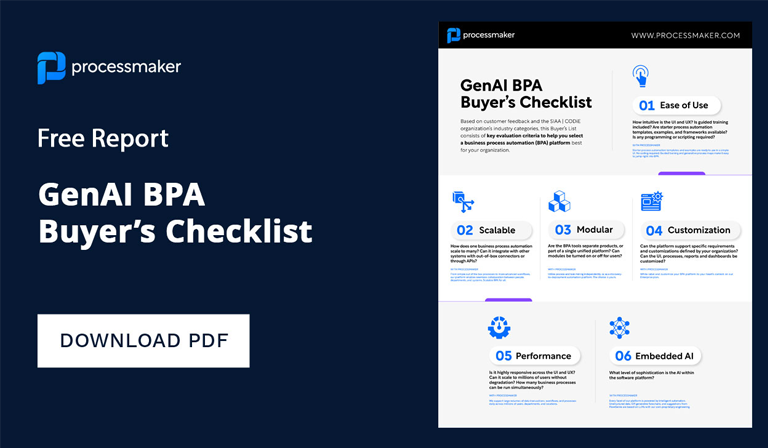In every organization, there comes a time for change. We need to adjust to shifting customer preferences, adopt new technologies, and adapt to mercurial market forces. To affect and manage change, organizations turn to two strategies: business process reengineering and continuous business process improvement. Let’s take a look at how these two transformative concepts can help you reach your business goals.
What is business process reengineering?
According to the management consultancy Bain & Company, business process reengineering, or BPR, involves the “radical redesign of core business processes to achieve dramatic improvements in productivity, cycle times, and quality.”
The keyword here is “radical.” BPR takes aim at large-scale change. Instead of tweaking things a step at a time, it’s demolishing the staircase and building an elevator.
Through a BPR lens, every activity should revolve around delivering customer value. An activity should reduce costs, improve turnaround time, boost quality, make explosively happy customers—or it’s fat or fluff to be cut or reshaped.
Business process reengineering is a “back-to-the-drawing-board” mentality. Every step should focus on fast, high-quality customer satisfaction, and any barriers are fodder for a reengineering initiative. You might:
- Reorganize teams (shake up responsibilities, restructure, downsize, upsize)
- Eliminate unproductive, redundant, or ineffective activities
- Reduce fragmentation of work by bolstering inter-department transparency
Smash the mold, flip the tables, break through the walls if needed. BPR isn’t just about recalculating your driving route to find a faster way, but wondering whether a helicopter or rocket might be a viable alternative—while also considering that you don’t need to reach that destination at all.
What is continuous business process improvement?
While BPR involves rethinking an organization from the ground up, continuous business process improvement involves incremental change.
NASA, responsible for some of the earth-shattering discoveries that have changed our understanding of the universe, is a champion of continuous improvement. They take extraordinary swings, but they rarely do it all in one fell swoop. Every finding is an amalgam of smaller stepping stones.
Consider Apollo 10, the penultimate mission before the first man landed on the moon. While skeptics questioned why the astronauts didn’t just descend to the moon a mission early—they were only eight nautical miles from the surface, after all!—the orbital ballet was intended to collect data for future rendezvous maneuvers. The main objective for this mission was to gather more engineering data to perfect ascent simulations back in Houston—a more step-by-baby-step mindset than BPR.
Business process reengineering vs. continuous improvement: how do they differ?
Both business process engineering and continuous improvement focus on reshaping existing processes, but BPR aims to shake things up fundamentally.
BPR focuses on outcomes instead of individual tasks. Rearranging the order of tasks, eliminating tasks; these are more in the continuous improvement wheelhouse. Upending a process or expanding the horizons of your company ethos falls under the BPR umbrella.
Bear in mind: even after you implement a seismic BPR-level change, you need to adopt a continuous improvement mindset to ensure its success. By doing so, you can measure the effectiveness of your transformation against key KPIs and make further tweaks and changes as necessary.
How can you decide which is right for you?
Business process reengineering involves rejecting some of the antiquated beliefs milling through your organization and replacing them with entirely fresh ways of thinking. Consider these scenarios:
- Do we need to cut a paper-based form down to one page, or should you create a self-service platform that clients can complete at home?
- Should we improve the ruggedness of a CD player so music on a 10-track disc doesn’t skip, or should we find a way to fit millions of songs in your pocket without interruption?
- Should we hire more people to handle delivery status inquiries, or release a tracking number system so customers can check for themselves?
- Do we need to automate our monthly reports so we can create them faster—or first find out if anybody even bothers to read them?
- Should we continue on with rope-climbing courses so astronauts can train to shimmy out of the lunar module (true story), or should we ixnay the idea in favor of a lightweight ladder?
- When you need to make changes in your organization, start with these questions:
What is your main objective? Are you looking to streamline a process by introducing automation? If you’re structuring around a longer-term objective, then small steps, like those orchestrated by NASA, might be your best bet. But, if you can’t reach your goals without tossing the current way of doing things entirely out the window, proceed with BPR in mind.
How big is your organization? For a small and snappy start-up, tweaks or changes of any size can be a no-brainer. But, if you want to change how thousands of employees perform their job duties, you’re in for a longer and more laborious journey. Larger organizations must weigh the time and effort for a proposed BPR initiative against the ultimate value it can deliver for their customer.
How many team members are touched by this change? Face it; old habits die hard. Trying to overhaul traditional techniques or structures needs significant buy-in. Typically, in a continuous improvement atmosphere, changes can be introduced on the team or department level. For a business reengineering initiative, the CEO or owner needs to champion the change.
Both business process reengineering and continuous improvement are effective ways to rethink your organization—just on differing scales. According to Dr. Michael Hammer, an expert in business process reengineering, sometimes you need to “stop paving cow paths. Instead of embedding outdated processes, we should obliterate them and start over.”





